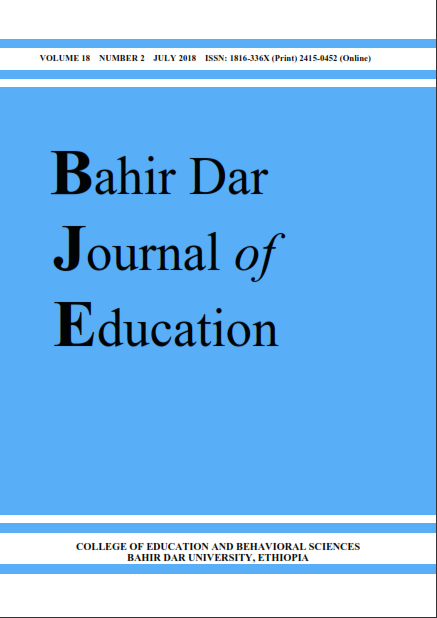Challenges in providing correctional service education: A case study in a correctional institution in Amhara Regional State, Ethiopia
Abstract
The purpose of this study was to identify the challenges encountered in the provision of correctional service education in a correctional institution in Amhara National Regional State, Ethiopia. Guided by the constructivist paradigm, the study employed qualitative case study as a strategy, involving sixteen participants selected through purposive sampling from one institution. Data collected through one-on-one interviews and focus group discussions were thematically analysed. The study identified long and stringent procedures, inmates’ misbehaviour, lack of resources and facilities, mismatch between inmates’ needs and curricular contents, and lack of monitoring and evaluation as challenges affecting the provision of education. It was concluded that the majority of challenges faced in the case correctional institution occurred as a result of inadequate attention and conflicting missions of the correctional institution (security and rehabilitation) and the tendency of prioritizing security over rehabilitation. In order to mitigate the problems and to improve the provision of correctional service education, possible suggestions are forwarded.References
Barringer-Brown, Ch. (2015). Teaching college courses in selected correctional facilities in the commonwealth of virginia. Journal of Education & Social Policy 2(2), 47-52.
Baxter, P., & Jack, S. (2008). Qualitative case study methodology: study design and implementation for novice researchers. The Qualitative Report, 13(4), 544-559.
Bazos, A., & Hausman J. (2004). Correctional education as a crime control program. UCLA School of Public Policy and Social Research, department of policy. Retrieved from http://www.ceanational.org/PDFs/ed-as-crime-control.pdf
Behan, C. (2007). Report from the European Prison Education Association. Journal of Correctional Education, 58, 320–321.
Biswalo, P. (2011). The role of adult education in the integration of inmates into society after a jail term: practical experiences from Swaziland. International Journal of Lifelong Education, 30(1), 71-81.
Boulianne, R. G., & Meunier, C. (1986). Prison education: Effects of vocational education on rehabilitation. McGill Journal of Education, 21(3), 217-228.
Brazzell, D., Crayton, A., Mukamal, D. A., Solomon, A. L., & Lindahl, N. (2009). From the classroom to the community: Exploring the role of education during incarceration and reentry. New York: The Urban Institute.
CILC. (2005). Comprehensive justice system reform program: baseline study report. Ministry of Capacity Building, Netherlands: Justice System Reform Program Office. Retrieved from http://www.cilc.nl/uploads/CILC%20Ethiopia%20D%2005-0103.pdf.
Creswell, J . W. (2007). Qualitative inquiry and research design: Choosing among five approaches (2 nd ed.). Thousand Oaks, CA: Sage.
Diseth, Å., Eikeland, O., Manger, T., & Hetland, H. (2008). Education of prison inmates: Course experience, motivation, and learning strategies as indicators of evaluation. Educational Research and Evaluation, 14(3), 201–214.
EHRC. (2012). International covenants of human rights. Addis Ababa: EHRC.
FDRE. (1995). The constitution of the federal democratic republic of Ethiopia. Addis Ababa.
Gulilat, A. (2012). The human rights of detained persons in Ethiopia: Case study in Addis Ababa. Unpublished MA Thesis. Addis Ababa University.
ILO. (n.d). The Mekelle Prison Project: Creating sustainable livelihood opportunities for women and youth. Country office for Ethiopia and Somalia. Addis Ababa: Impala Communication. Retrieved from http://www.ilo.org/pardev/developmentcooperation/WCMS_228592/lang--en/index.htm
Jovanic´, G. (2011). The role of education in the treatment of offenders. British Journal of Learning Support, 26(2), 79-82
Kabeta, G. G. (2017). Assessing the practices of prison education in selected prisons of Amhara National Regional State, Ethiopia. Unpublished PhD Dissertation, University of South Africa.
Langelid, T., Maki, M., Raundrup, K., & Svensson, S., 2009. Nordic prison education: A lifelong learning perspective. Copenhagen: Nordic Council of Ministers.
Onyango, O. J., 2013. The challenges facing rehabilitation of prisoners in Kenya and the mitigation strategies. International Journal of Research in Social Sciences, 2(2), 3943.
Patton, M.Q. (2002). Qualitative research and evaluation methods (3 rd ed.). California: Sage publications, Inc.
Sarkin, J. (2008). Prisons in Africa: An evaluation from a human rights perspective. International Journal on Human Rights, 5(9), 22-49.
Tadesse, T. (2011). Freedom from torture, inhuman or degrading treatment or punishment: The case of some selected prisons of Oromia National Regional State. Unpublished MA thesis, Addis Ababa University.
Tracy, S.J. (2013). Qualitative research methods: Collecting evidence, crafting analysis, communicating impact. Oxford: Wiley-Blackwell.
Ültanır, Y.G., & Ültanır, E. (2010). Exploring the curriculum dimensions of theories-based adult education - a sample course of Southeast Anatolian Region. International Journal of Instruction, 3(2), 3-24.
UN. (1948). Universal Declaration of Human Rights. New York: UN.
UNESCO. (1995). Basic education in prisons. Baltimore: UNESCO Institute for Education.
Vacca, J.S. (2004). Educated prisoners are less likely to return to prison. The Journal of Correctional Education 55(4), 297-304.
Warner, K. (2007). Against the Narrowing of Perspectives: How Do We See Learning, Prisons and Prisoners? Journal of Correctional Education, 58(2), 170-183.
Worku, A., Geberemariam, E., & Belete, T. (2014, March 21-23). ANRS Correctional institutions from where to where? Paper presented for panel discussion in Festival for Security Institutions in ANRS, organized by ANRS Correctional Centres Commission.
Yin, R. K. (2009). Case study research: Design and methods (4 th ed.). Thousand Oaks, California: SAGE Publications, Inc.
Authors who publish with this journal agree to the following terms:
- Authors retain copyright and grant the journal right of first publication with the work simultaneously licensed under a Creative Commons Attribution License that allows others to share the work with an acknowledgement of the work's authorship and initial publication in this journal.
- Authors are able to enter into separate, additional contractual arrangements for the non-exclusive distribution of the journal's published version of the work (e.g., post it to an institutional repository or publish it in a book), with an acknowledgement of its initial publication in this journal.
- Authors are permitted and encouraged to post their work online (e.g., in institutional repositories or on their website) prior to and during the submission process, as it can lead to productive exchanges, as well as earlier and greater citation of published work (See The Effect of Open Access).

